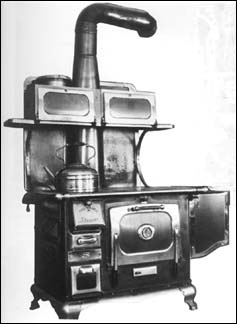
The author, Connie Williams, is doing graduate work in history at St. Cloud State University and has worked at the Paynesville Area Museum for several summers.
 |
(Editor's note: For the next year, we will present a series of articles that examine the years around 1900. Our purpose is to provide a comparison of the beginning of the 20th Century to its upcoming end. The author, Connie Williams, is doing graduate work in history at St. Cloud State University and has worked at the Paynesville Area Museum for several summers.
|
It is hard for us today to imagine a time before electricity. We take it for granted. When we enter a room, we automatically reach for a light switch. When the darkness of the room becomes bathed in light, it doesn't even settle on our brain. Our minds are already onto the agenda that brought us into the room in the first place.
Only when power goes out do we feel the loss, but not truly even then. Power is generally out for a very short time. Long enough for children to feel a rush and play in the darkness. Teenagers may get in their cars and go driving up and down the streets, while adults enjoy the sedateness of the dark and dig out grandmother's oil lamp. The adults sit around the old lamp and reminisce about a time they have only heard about romantically, called "the good old days" while the children play hide-and-seek.
Then in the midst of the reverie, the lights come back on and life goes on again - taking electricity for granted.
Farms in the darkness
Until the 1930s, work on farms in rural America was still done mainly by hand during the daytime or by lantern light. It wasn't until May 1936 that Congress passed the Rural Electrification Act (REA) bringing electricity to the American countryside.
Before electricity, a farmer had to water his cows by hand and milk them by hand, too. In dry weather, they hauled endless buckets from a deep well.
Livestock also had to be fed by hand. A farmer would pitch heavy loads of hay from the loft of his barn and then stomp on it to soften the hay enough so the cows could eat it. He would stick hundreds of ears one by one into a corn sheller and crank it for hours in order to feed his mules.
There was never enough daylight to finish his work. He often had to work after sundown in the dark and shadows, as farmers had done for centuries before.
The farmer might rise at 3:30 or 4 a.m. to milk his cows by hand. It took more than two hours to do 20 cows. He had to work by kerosene lantern, which dangled a safe distance from the ceiling and cast a huge shadow on the floor, making it almost impossible to see between and beneath the cows. Placing the lantern on the floor created a sort of double jeopardythe light was better, but so were the chances of starting a fire. The farmer had to finish milking before daylight, because every hour of daylight was needed for field work.
The milk was kept cool in water either pumped by hand, windmill, or maybe by gas engine.
"Mrs. John Weiss, near Grove City, enjoys cooking meals, and more meals, and no wonder because she uses electricity and a new Hot Point, push button range that does everything automatically just by touching a button and a dial."
The wood stove was hard to start up and even harder to keep going. The damper that opened into the firebox created only a small draft even on a breezy day and on a windless day, no draft. Without a draft, the fire would flicker out. Wood stoves were dirty, the smoke blackened the walls and ceilings. The ash box had to be emptied twice a day and the stove could not be left unattended. While baking you had to keep constant watch on the fire and even then the stove didn't keep an even temperature. Every time the heat slacked, you had to throw logs or corn cobs into the firebox.
Canning
Canning required constant attention at the stove and the fire had to be roaring hot. The housewife was either bending down to the flames to empty the firebox or standing over them while cooking on top of the stove.
When canning peaches, for example. The sugar went into the iron canning pot first. It had to be stirred constantly. The peaches were peeled earlier and boiled for an hour. They, like the sugar, had to be stirred constantly, so they wouldn't stick to the pot. This was boiled until it was a soft and mushy jam and then packed into jars which had been boiled earlier in another pot. They were sealed with wax. This was an all day job with the wife standing over a blazing fire.
Water
The wash
The clothes were lifted out of the vat by the paddle and put in a second zinc tub for rinsing. The third zinc tub contained bluing. Sometimes there was a fourth tub containing starch.
When this round of clothes was finished, she would start on the next group of clothes, going from white to the overalls. More hauling water, more boiling, scrubbing, stirring, and rinsing.
Then the clothes were hung on the outside line for drying.
Ironing
The irons got a muddy film on the bottom from the sooty stove and had to be cleaned often. The irons could also give terrible burns, but the worst thing was the heat. Just as with canning, the fire would blaze in the wood stove all day, filling the kitchen with heat and smoke.
Kerosene lamps
Lighting the lamps was frustrating. Even when the wick was trimmed just right, it would flare up or die down.
Pat O'Shea of Litchfield remembers his family was fortunate enough to own a Coleman gasoline lamp. Only white gasoline could be used in the lamp, but it gave off much brighter light. He says "I think back now about how dangerous they wereextremely dangerous."
Baths
Brothers and sisters, I want to tell you this. The greatest thing on earth is to have the love of God in your heart, and the next greatest thing is to have electricity in your house."
(Next week will be part II of rural electrification -"The lines went up.")
The cities of America were electrified first. They started to receive 'night as light as day' 30 years earlier, while on the farm chores were done by the shadowed light of a lantern.
REA News, May 1949 Wood stoves
Wood stoves
Trees needed to be cut down and chopped into four-foot lengths so they could be stacked in cords. Wood for the house was cut shorter. Wood was sawed by hand or by swinging an axe.
Without electricity and refrigeration, vegetables and fruit had to be canned the very day they became ripe. From June through September, something was coming ripe almost every daypeaches, strawberries, gooseberries, raspberries, and blueberriestomatoes before okra, okra before zucchini, and zucchini before corn.
Water either had to be carried from a stream or lifted one bucket at a time from a well. Most of the hauling was done by women. First, she would have to wrestle the heavy wooden lid off the well, then she cranked a bucket of 30 pounds up 50 feet or more to the surface. Windmills came later to farms to pump water and later gas engines were installed to do some of the work.
Monday was typically wash day. The wash was done outside in a huge vat of boiling water suspended over a roaring fire. The clothes were scrubbed on a washboard by a woman bending over a zinc tub. The water was hard and the soap was made from lye. The farm wife would wring out each piece of clothing and put in the big vat of boiling water. She used a wooden paddle to stir the clothes.
Tuesday was usually ironing day. The iron got its name because it was made of iron. It weighed six or seven pounds and was called a sad-iron. It had to be heated on the wood stove. As it only retained heat for a short time, a man's shirt, for example, would take two irons. A woman could have four irons going at once. She would transfer the handle of the iron from one iron to the next.
The circle of light cast by the kerosene lamp was small. An impoverished farm never had enough lamps. Sometimes all the children sat around one good lamp and studied. Later mom would finish sewing by the same lamp. Outside the small circle of light, the room was dark. A lamp gave off about 25 watts of light.
In the summer bathing was done in the creek. In the winter, wood had to be hauled in first and set to burning in the stove; then water had to be lugged in and set to boiling on the stove. Then it was poured into a washtub on the kitchen floor. Baths were usually taken on Saturday night for church on Sunday morning.
Farmer giving witness in a rural Tennessee church in the early 1940s